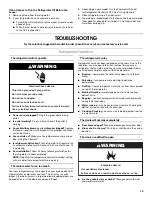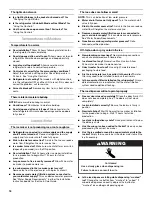
15
If You Choose to Turn the Refrigerator Off Before You
Leave:
1. Remove all food from the refrigerator.
2. If your refrigerator has an automatic ice maker:
■
Turn off the water supply to the ice maker at least one day
ahead of time.
■
When the last load of ice drops, raise the wire shutoff arm
to the OFF (up) position.
3. Depending on your model, turn the Thermostat Control
(or Refrigerator Control) to OFF. See “Using Controls.”
4. Clean refrigerator, wipe it, and dry well.
5. Tape rubber or wood blocks to the tops of both doors to prop
them open far enough for air to get in. This stops odor and
mold from building up.
TROUBLESHOOTING
Try the solutions suggested here first in order to avoid the cost of an unnecessary service call.
Refrigerator Operation
The refrigerator will not operate
■
Power cord unplugged? Plug into a grounded 3 prong
outlet.
■
Is outlet working? Plug in a lamp to see if the outlet is
working.
■
Household fuse blown or circuit breaker tripped? Replace
the fuse or reset the circuit breaker. If the problem continues,
call an electrician.
■
Are controls on? Make sure the refrigerator controls are on.
See “Using the Controls.”
■
Is refrigerator defrosting? Your refrigerator will regularly run
an automatic defrost cycle. Recheck in 30 minutes to see if it
is operating.
■
New installation? Allow 24 hours following installation for
the refrigerator to cool completely.
NOTE: Adjusting the temperature controls to coldest setting
will not cool either compartment more quickly.
The motor seems to run too much
Your new refrigerator may run longer than your old one due to its
high-efficiency compressor and fans. The unit may run even
longer if the room is warm, a large food load is added, doors are
opened often, or if the doors have been left open.
The refrigerator is noisy
Refrigerator noise has been reduced over the years. Due to this
reduction, you may hear intermittent noises from your new
refrigerator that you did not notice from your old model. Below
are listed some normal sounds with an explanation.
■
Buzzing - heard when the water valve opens to fill the ice
maker
■
Pulsating - fans/compressor adjusting to optimize
performance
■
Rattling - flow of refrigerant, water line, or from items placed
on top of the refrigerator
■
Sizzling/Gurgling - water dripping on the heater during
defrost cycle
■
Popping - contraction/expansion of inside walls, especially
during initial cool-down
■
Water running - may be heard when water melts during the
defrost cycle and runs into the drain pan
■
Creaking/Cracking - occurs as ice is being ejected from the
ice maker mold.
The doors will not close completely
■
Door blocked open? Move food packages away from door.
■
Bin or shelf in the way? Push bin or shelf back in the correct
position.
The doors are difficult to open
■
Are the gaskets dirty or sticky? Clean gaskets with mild
soap and warm water.
Electrical Shock Hazard
Plug into a grounded 3 prong outlet.
Do not remove ground prong.
Do not use an adapter.
Do not use an extension cord.
Failure to follow these instructions can result in death,
fire, or electrical shock.
WARNING
WARNING
Explosion Hazard
Use nonflammable cleaner.
Failure to do so can result in death, explosion, or fire.
Содержание JS42NXFXDW00
Страница 18: ...18 WATER FILTER CERTIFICATIONS...
Страница 22: ...22 Notes...
















































